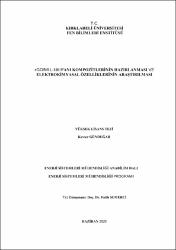| dc.contributor.author | Günduğar, Kevser | |
| dc.date | 2021-01 | |
| dc.date.accessioned | 2021-04-20T08:32:39Z | |
| dc.date.available | 2021-04-20T08:32:39Z | |
| dc.date.issued | 2020-06-30 | |
| dc.identifier.citation | Günduğar, K. (2020). "rGO/MIL-101/PANI Kompozitlerinin Hazırlanması ve Elektrokimyasal Özelliklerinin Araştırılması", Yüksek Lisans Tezi: Kırklareli Üniversitesi Fen Bilimleri Enstitüsü. | |
| dc.identifier.uri | https://hdl.handle.net/20.500.11857/1449 | |
| dc.description.abstract | Yenilenebilir enerjiye yapılan yatırımların artması ve taşınabilir elektroniklerin yaygınlaşması sebebiyle elektrik enerjisi depolama ihtiyacı doğmuştur. Lityum iyon pilleri ve süperkapasitörler elektrik enerjisini elektrokimyasal olarak depolayabilen iki önemli teknolojidir. Süperkapasitörler üstün güç yoğunlukları ile öne çıkarken enerji yoğunlukları lityum iyon pillerinin altındadır. Bu sebeple süperkapasitörlerin güç yoğunluklarından feragat etmeden, enerji yoğunluklarını arttırmak araştırma konusu olmuştur. Süperkapasitör uygulamalarında kullanılmak üzere hazırlanan malzemelerin gözenekli, elektrolit içerisinde uzun süre kararlı, elektriksel iletkenliği ve yük aktarım yeteneği yüksek olması istenmektedir. Metal organik kafesler, ligantların metal iyonlarını birbirine bağlamasıyla oluşan gözenekli malzemelerdir. MOF'lar çoğu zaman elektrolitler ile iyi etkileşebilen gözenek yapısıyla süperkapasitör uygulamaları için aranan özelliklere sahiptir. Ancak elektriksel iletkenliklerinin düşük olması elektrokimyasal uygulamalardaki performanslarını olumsuz etkilemektedir. MOF'ların süperkapasitif özellikleri araştırılmaya başlanmıştır ancak MOF sınıfı malzemelerin elektrokimyasal enerji depolama mekanizması hakkında hala yeterli seviyede bilgiye ulaşılamamıştır. İletken polimerler ailesinden polianilinin (PANI), süperkapasitör ve lityum iyon pillerindeki uygulamaları iletkenlik arttırıcı olarak araştırılmıştır. PANI'nin morfolojisi de elektrokimyasal ölçümün sonucuna önemli derecede etki yapmaktadır. PANI'in esnek doğası diğer malzemelerle kolay bir şekilde kompozitleşmesine olanak tanır. PANI, grafen gibi malzemelerle kompozitleştirildiğinde daha yüksek kararlılık, yüksek iletkenliğe sahip nanokompozitlerin oluşturmaktadır. Tez çalışmasında MIL-101(Cr) ve MIL-101(Fe)'nın indirgenmiş grafen oksit ve polianilin ile yeni nanokompozitleri hazırlanmıştır. MIL-101(Cr) ve ikili kompozitleri hem hidrotermal hem de mikrodalga yöntemiyle sentezlenmiştir. Hazırlanan malzemeler elementel analiz, FT-IR, XRD, FE-SEM ve 77 K'de N2 adsorpsiyonu ve desorpsiyonu analizleri ile karakterize edilmiştir. Kompozitlerin elektrokimyasal özellikleri 0,5 M Na2SO4 ve 2M KOH içerisinde döngülü voltametri (CV), galvanostatik şarj deşarj (GCD) ve elektrokimyasal empedans spektroskopisi (EIS) yöntemleriyle araştırılmıştır. Kompozitlerin grafen ilavesiyle EDLC tipi kapasitif özellikleri gelişirken, PANI ilavesiyle ise psedokapasitif özelliklerinde iyileşme gerçekleştiği gözlenmiştir. GCD yöntemiyle en yüksek spesifik kapasitans değerine rGO-6/MIL-101(Fe)/PANI kompoziti ile ulaşıldığı belirlenmiştir. Grafen ilavesiyle MOF'ların iç dirençlerinin azaldığı EIS ile belirlenmiştir. içeren üçlü kompozitlerin şarj/deşarj kararlılığı testlerinde ilk 500 döngüde kapasitansın geliştiği 1000. döngüye kadar da kararlı kaldığı tespit edilmiştir. MIL-101(Fe) içeren üçlü kompozitin ise 1000. Döngüye kadar kapasitansının kararlılığını sürdürdüğü görülmüştür. | |
| dc.description.abstract | "Due to the increase in investments in renewable energy and the widespread use of portable electronics, electrical energy storage needs have arisen. Lithium ion batteries and supercapacitors are two important technologies that can store electrochemical electrical energy. While supercapacitors stand out with their superior power densities, their energy densities are below lithium ion batteries. For this reason, it has been the subject of research to investigate increasing the energy densities without sacrificing the power densities of the supercapacitors. Materials prepared for use in supercapacitor applications should be porous, long-term stable in the electrolyte, high electrical conductivity and charge transfer capability. Metal organic frameworks are porous materials formed by ligating metal ions to metal ions. MOFs have often sought for supercapacitor applications with their pore structure that can interact well with electrolytes. However, low electrical conductivity affects their performance in electrochemical applications negatively. Supercapacitive properties of MOFs are being investigated, but sufficient information about the electrochemical energy storage mechanism of MOF class materials has not been reached yet. Applications of polyaniline (PANI) from the family of conductive polymers in supercapacitors and lithium-ion batteries have been investigated as conductivity enhancers. It has a significant effect on the result of electrochemical measurement in PANI's morphology. The flexible nature of PANI allows it to be easily composited with other materials. When PANI is composite with materials such as graphene, it creates higher stability, high conductivity nanocomposites. In the thesis, new nanocomposites were prepared with reduced graphene oxide and polyaniline of MIL-101(Cr) and MIL-101(Fe). MIL-101(Cr) and its binary composites were synthesized by both hydrothermal and microwave method. The prepared materials are characterized by elemental analysis, FT-IR, XRD, FE-SEM and N2 adsorption and desorption analysis at 77 K. Electrochemical properties of composites were investigated by cyclic voltammetry (CV), galvanostatic charge discharge (GCD) and electrochemical impedance spectroscopy (EIS) methods in 0.5 M Na2SO4 and 2M KOH. While EDLC type capacitive properties improved with the addition of graphene in composites, an improvement in psedocapacitive properties was observed with the addition of PANI. It has been determined with the GCD method that the highest specific capacitance value is reached with the rGO-6/MIL-101(Fe)/PANI composite. It was determined by EIS that the internal resistance of MOFs decreased with the addition of graphene. In the charge / discharge stability tests of the ternary composites gradually increased in the first 500 cycles, the capacitance remained stable up to the 1000th cycle. Te ternary composite containing MIL-101 (Fe) maintained its stability up to the 1000th cycle " | |
| dc.language.iso | tur | |
| dc.publisher | Fen Bilimleri Enstitüsü | |
| dc.rights | info:eu-repo/semantics/openAccess | |
| dc.rights.uri | http://creativecommons.org/licenses/by-nc/3.0/us/ | * |
| dc.subject | Nanokompozitler | |
| dc.subject | Süperkapasitör | |
| dc.subject | Metal organic framework | |
| dc.subject | Nanocomposites | |
| dc.subject | Supercapacitors | |
| dc.subject | Metal Organik Kafesler | |
| dc.subject | Metal Organic Framework | |
| dc.title | rGO/MIL-101/PANI Kompozitlerinin Hazırlanması ve Elektrokimyasal Özelliklerinin Araştırılması | |
| dc.title.alternative | Preparation and Electrochemical Properties of rGO/MIL-101/PANI Composites | |
| dc.type | masterThesis | |
| dc.department | Enstitüler, Fen Bilimleri Enstitüsü, Enerji Sistemleri Mühendisliği Ana Bilim Dalı | |
| dc.relation.publicationcategory | Tez | |
| dc.institutionauthor | Günduğar, Kevser | |





















